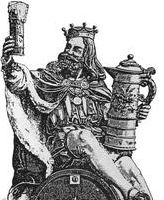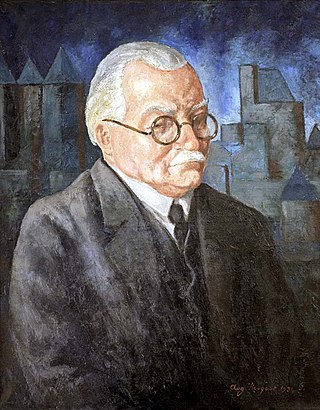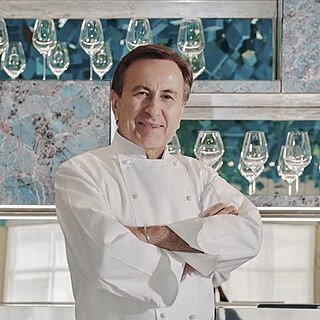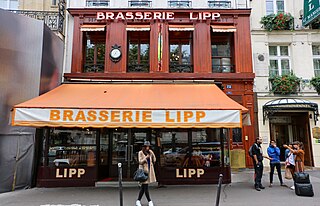
The Lumière brothers, Auguste Marie Louis Nicolas Lumière and Louis Jean Lumière, were French manufacturers of photography equipment, best known for their Cinématographe motion picture system and the short films they produced between 1895 and 1905, which places them among the earliest filmmakers.

French cuisine is the cooking traditions and practices from France. In the 14th century, Guillaume Tirel, a court chef known as "Taillevent", wrote Le Viandier, one of the earliest recipe collections of medieval France. In the 17th century, chefs François Pierre La Varenne and Marie-Antoine Carême spearheaded movements that shifted French cooking away from its foreign influences and developed France's own indigenous style.

The cuisine of the American Midwest draws its culinary roots most significantly from the cuisines of Central, Northern and Eastern Europe, and Indigenous cuisine of the Americas, and is influenced by regionally and locally grown foodstuffs and cultural diversity.

A restaurant is an establishment that prepares and serves food and drinks to customers. Meals are generally served and eaten on the premises, but many restaurants also offer take-out and food delivery services. Restaurants vary greatly in appearance and offerings, including a wide variety of cuisines and service models ranging from inexpensive fast-food restaurants and cafeterias to mid-priced family restaurants, to high-priced luxury establishments.

A profiterole, chou à la crème, also known alternatively as a cream puff (US), is a filled French choux pastry ball with a typically sweet and moist filling of whipped cream, custard, pastry cream, or ice cream. The puffs may be embellished or left plain or garnished with chocolate sauce, caramel, or a dusting of powdered sugar.

Gambrinus is a legendary European culture hero celebrated as an icon of beer, brewing, joviality, and joie de vivre. Typical representations in the visual arts depict him as a rotund, bearded duke or king, holding a tankard or mug, and sometimes with a keg nearby.

Baked Alaska, also known as Bombe Alaska, omelette norvégienne, omelette surprise, or omelette sibérienne depending on the country, is a dessert consisting of ice cream and cake topped with browned meringue. The dish is made of ice cream placed in a pie dish, lined with slices of sponge cake or Christmas pudding, and topped with meringue. After having been placed in the freezer, the entire dessert is then placed in an extremely hot oven for a brief time, long enough to firm and caramelize the meringue but not long enough to begin melting the ice cream. Another common method of browning the meringue is to torch the dessert, sometimes even lighting it on fire for presentational purposes.

Lithuanian cuisine features products suited to the cool and moist northern climate of Lithuania: barley, potatoes, rye, beets, greens, berries, and mushrooms are locally grown, and dairy products are one of its specialties. Various ways of pickling were used to preserve food for winter. Soups are extremely popular, and are widely regarded as the key to good health. Since it shares its climate and agricultural practices with Northern Europe, Lithuanian cuisine has much in common with its Baltic neighbors and, in general, northern countries.

In France, Flanders, and the Francophone world, a brasserie is a type of French restaurant with a relaxed setting, which serves dishes and other meals.

Prosper Montagné was one of the most renowned French chefs of the Belle Époque and author of many books and articles on food, cooking, and gastronomy, notably Larousse Gastronomique (1938), an encyclopedic dictionary of the French culinary arts. While Montagné was once as famous as his friend Auguste Escoffier, and was one of the most influential French chefs of the early twentieth century, his fame has faded somewhat. In the 1920s, Montagné, Escoffier, and Philéas Gilbert—their close friend and collaborator, and an acclaimed chef and writer in his own right—were the French chefs and culinary writers esteemed above others by many French journalists and writers. After Montagné's death, the chef and author Alfred Guérot's description of the troika as the "celebrated contemporary culinary trinity: Auguste Escoffier, the father; Philéas Gilbert, the son; Prosper Montagné, the spirit" reflects the reverence in which all three were held by the French culinary community.

Daniel Boulud is a French chef and restaurateur with restaurants in New York City, Palm Beach, Miami, Toronto, Montréal, Singapore, the Bahamas, and Dubai. He is best known for his eponymous restaurant Daniel, opened in New York City in 1993, which currently holds two Michelin stars.

Parisian cafés are a type of café found mainly in Paris, where they can serve as a meeting place, neighborhood hub, conversation matrix, rendez-vous spot, and a place to relax or to refuel for Parisian citizens.
Restaurants fall into several industry classifications, based upon menu style, preparation methods and pricing, as well as the means by which the food is served to the customer. This article mainly describes the situation in the US, while categorisation differs widely around the world.

Most beer sold in France is pilsner lager, mass-produced by major breweries which control over 90% of the market, although there are also traditional beer styles, such as top-fermented Bière de Garde, and a number of microbreweries.

Brasserie Lipp is a brasserie located at 151 Boulevard Saint-Germain in the 6th arrondissement of Paris. It sponsors an annual literary prize, the Prix Cazes, named for a previous owner.

Paris in the Belle Époque was a period in the history of the city during the years 1871 to 1914, from the beginning of the Third French Republic until the First World War. It saw the construction of the Eiffel Tower, the Paris Métro, the completion of the Paris Opera, and the beginning of the Basilica of Sacré-Cœur on Montmartre. Three lavish "universal expositions" in 1878, 1889, and 1900 brought millions of visitors to Paris to sample the latest innovations in commerce, art, and technology. Paris was the scene of the first public projection of a motion picture, and the birthplace of the Ballets Russes, Impressionism, and Modern Art.

Fouquet's Paris is an historic brasserie restaurant in Paris, France located at 99 Avenue des Champs-Élysées. Part of Hotel Barrière Le Fouquet's Paris, the site is known for its red awnings spread over two terraces on the Champs-Élysées and Avenue George V.

Bardot Brasserie is a French restaurant in Las Vegas, Nevada in the United States. Owned by Michael Mina, the restaurant is located at the Aria Resort and Casino.

Georges Perrier is a French chef who emigrated to the United States in 1967 and lived in Philadelphia, where he founded and ran Le Bec-Fin and other restaurants, bars and cafés across the country.

Mère is an honorary title given to talented female professional cooks, many of whom had no formal training, in France during the 18th, 19th, and 20th centuries. Between 1759 and the end of the 20th century multiple women have been called Mère. Their work turned the city of Lyon and its environs into the gastronomic center of France and the world, and the most famous of them, Mère Brazier, is regarded as "the mother of modern French cooking".





















